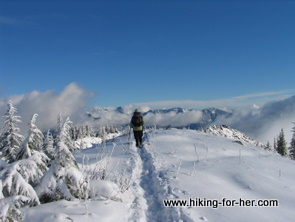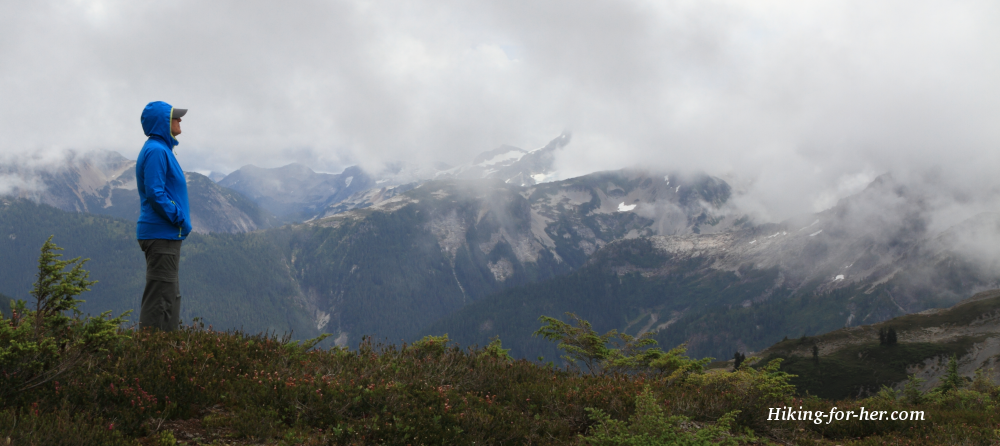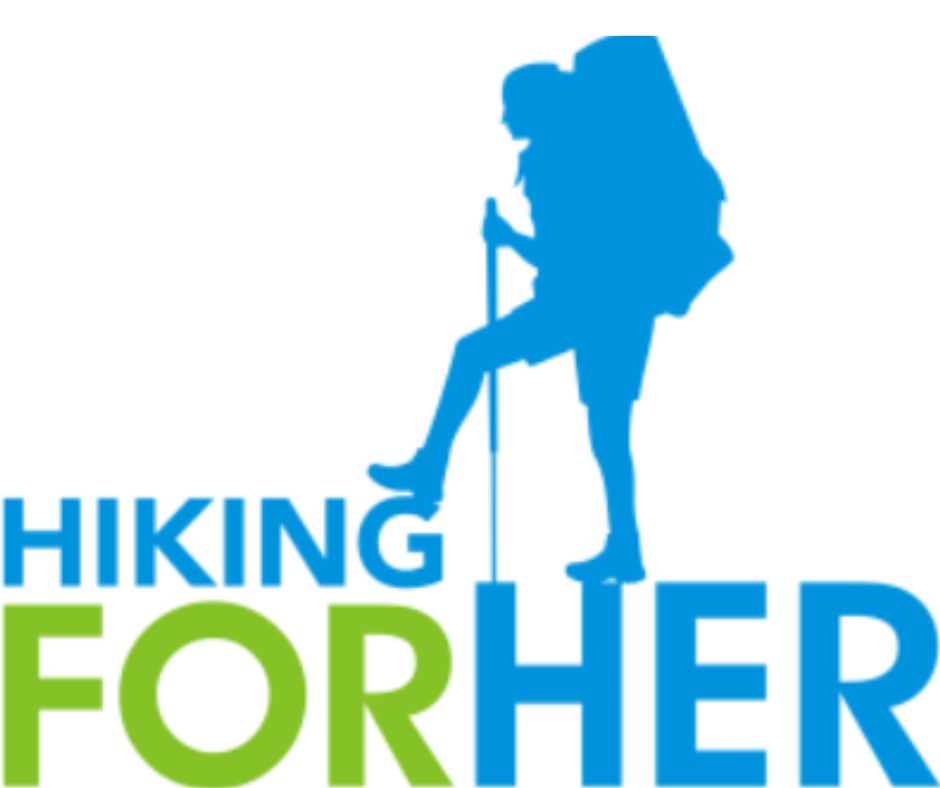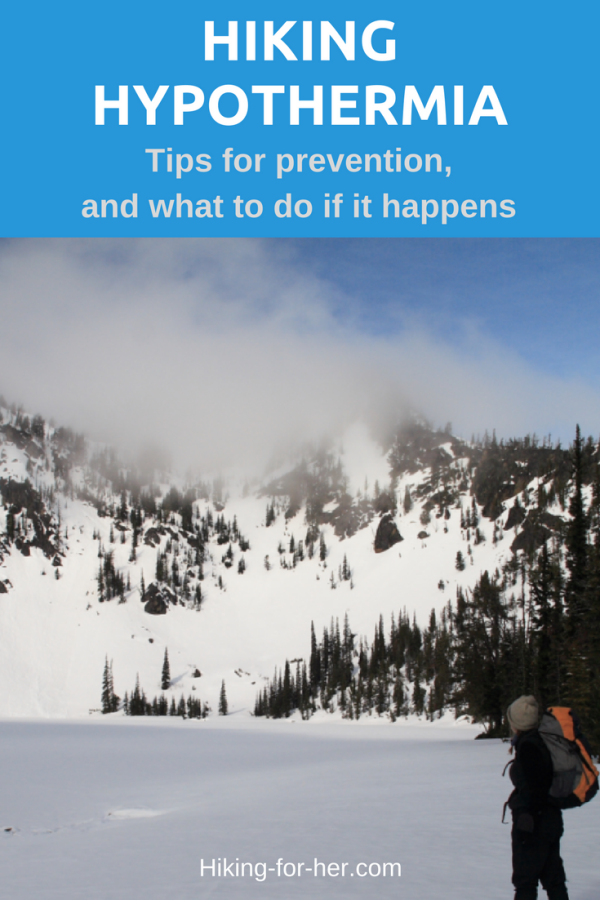Hiking Hypothermia:
Not Your Friend
By Diane Spicer
Hypothermia defined
Hiking hypothermia is no joke.
But many hikers laugh off the signs and symptoms.
Or fail to recognize them.
Others blow them off as a minor inconvenience - until a progression to something much worse really grabs attention away from the hiking trail.
So let's define hiking hypothermia before we go any further.
HYPOTHERMIA:
"below temperature", referring to your internal body temperature.
- If you get too cold on the outside when you're in the outdoors, you'll get too cold on the inside.
- That spells big trouble for the functions of your internal organs - important stuff like heart and lungs.
In self defense, your body gives you "signs" and "symptoms" that something is going wrong.
Cries for more warmth, actually. Let's give some examples.
Signs of hypothermia
Signs are things that other people can notice about you:
- shivering,
- stuttering over words or having trouble recalling facts,
- tripping or stumbling on an easy trail,
- acting a little "spacey", or
- suddenly not wanting to move.
These signs are as objective as a bright red stop sign, and should alert your trail buddies (if you have them - solo hikers are going to have to be extra cautious) that something has changed in your body.
Hypothermia symptoms
Symptoms are things going on inside of you that should awaken little alarm bells in the ancient lizard "survival" part of your brain:
- feeling dizzy or disoriented or sleepy,
- having sudden hunger pangs -or- feeling like you want to vomit,
- a pounding heart & an increase in the rate of your breaths which can't be explained by your current exertion level.
These subjective pieces of information are rooted in your body - you're the subject!
Speak up to your trail buddies if you note these symptoms.
If you're solo, pay attention and act.
Never chide yourself for being clumsy or slow - recognize it for what it is.
The bad news first
The bad news: Together, these signs and symptoms will escalate until they become extreme, if you or your hiking partners don't take action.
And frostbite might also enter the
picture - frozen body tissues. Eww!
So ignoring these little postcards from your body is absolutely the wrong thing to do for hiking hypothermia.
- Your body is letting you know that something is seriously amiss as you pass through the stages of falling internal body temperature.
Let's bust some
hypothermia myths
To begin, I'm going to do a little myth busting about hiking hypothermia for you.
Then you can decide which actions to take to prevent it, and treat it when it's right in front of you.
 Hiking hypothermia can strike at any point during your hike.
Hiking hypothermia can strike at any point during your hike.
Hiking Hypothermia
Myth #1
Only hikers in extremely cold snowy conditions like those pictured above are at risk of hiking hypothermia.
Not true!
There are many conditions which can rob your body of its heat.
The critical question is - how much heat will you lose?
Examples of conditions which can lead to hiking hypothermia:
- The conditions pictured above: cold and snow, with the potential to become wet and chilled if it starts to snow or you become injured and roll in the snow.
- Windy cold conditions with inadequate clothing or shelter.
- Slipping into cold water while navigating a lake shoreline or crossing a stream.
- Failing to don a hat, gloves, windproof and waterproof layers when conditions deteriorate.
- Ignoring adequate hydration and food intake in cold weather.
- Hiking really hard, working up a sweat, and being exposed to cold, wet, or windy conditions without taking action.
- Drinking alcohol while exposed to foul weather conditions (hiking flasks are fun to pass around at base camp, but should not be pressed into service when the weather sucks on the trail).
Hiking Hypothermia
Myth #2
Only really young, or really old hikers, are at risk.
It's true that kids and elders have a tougher time with thermoregulation (adjusting body temperature to changing conditions).
Smaller people (such as kids and small women) lose body heat faster than bigger people.
And keep an eye on the kids in cold weather hiking conditions. They are easily distracted by fun activities on the trail, and may get really cold but not speak up until blue lips occur.
Older hikers are more likely to be on medications or have poor circulation for other medical reasons.
So these folks need to be watched more carefully in nasty conditions, or after exposure to cold water.
However, it's not true that if you're a healthy 20, 30, or 40-something you're immune to hypothermia risks on the trail.
We all have a proper range of internal temperature "set points" (textbooks say 37C or 98.6F), and anyone can get too cold (also too hot. That's a different story).
If you're a smoker, your circulation is not as robust as others.
If you consume alcohol during a hiking trip, your circulation is impaired to some degree.
Pay attention to your fatigue level. Pushing past your limits makes you more vulnerable when you're cold and wet.
And in my experience, males are less likely to notice cold conditions.
Or maybe they're less likely to comment on them? I don't know.
But they could slip into the early stages of hypothermia without being aware of it.
So keep an eye on the guys, too, especially older males with chronic health conditions such as diabetes.
Hiking Hypothermia
Myth #3
Shivering means you're in serious trouble.
Not at first!
Shivering is caused by your skeletal muscles (the ones that power you up the trail) reacting to decreased blood flow. You can't really control the shivering, and that's good - it's an inbuilt mechanism to create heat temporarily.
If the shivering escalates to the point where it interferes with your ability to open your water bottle, or hang onto your hiking poles, that's when things wander into the Land of Hiking Hypothermia.
Watch your trail companions for excessive shivering - it's one of the first signs that trouble is brewing.
If you catch yourself shivering really hard and can't over ride the shaking, it's time to take immediate action.
Every minute that ticks by without getting warmer is costing you body temperature that is going to be hard to increase unless drastic measures are taken.
And if you're on the trail, you don't have access to a medical team or emergency department, right? You're going to have to handle hiking hypothermia by yourself.
So don't blow it off when your hands start to shake or you feel shivers traveling up and down your body. It's a signal that your core body temperature is dropping.
Avoiding & spotting
hypothermia
By now you get the picture of how dangerous hiking hypothermia is.
But what are you going to do about it?
If you're a solo hiker, you're going to have to catch the signs and symptoms of hiking hypothermia in yourself at their earliest stage.
Stay
alert to changing weather conditions and put on appropriate gear, or
take/put up shelter quickly before you start to shake and shiver.
If you allow yourself to get wet on top of being cold, you're asking for major trouble. If you're shaking too hard to pitch your tent, how are you going to change into a dry set of clothes? Or warm up fluids and food to quickly consume?
If you're on a solo day hike, don't leave home without looking at weather forecasts. If you know the conditions are iffy, rethink your trip or be sure you have the right gear in your pack.
Be a good buddy
Trail companions buy you a bit of breathing room, because hopefully everyone is checking in with each other if a cold wind whips up, or a downpour occurs.
It's your responsibility to monitor anyone who falls into cold water.
- Fish
them out, then dry them off however you can.
- Don't let large amounts of time go by without observing behavior (looking for sleepiness or reluctance to keep up) or asking questions (to evaluate speech and coherence).
The person might become combative or deny that her behavior is deteriorating.
- Be prepared to take charge and be firm.
Avoid the potential for further trouble - falling into water or off slippery surfaces, tripping on tree roots and face planting, anything that would escalate the situation.
4 action steps to take
to reverse hypothermia
on the trail
Once signs and symptoms of hypothermia are present, here's a plan of action.
NOTE: This is not medical advice, just practical ideas.
You'll have to modify these steps to fit the precise conditions and gear availability.
Step 1: Get the hiker into a warmer situation.
Some ideas:
- Pitch
a tent, strip off wet clothing, get her into a dry sleeping bag where
she can dry off and warm up. If you can pre-warm the bag with a hot
water bottle or a dry hiking companion, so much the better. Be sure to support the "warming companion" with food and drink in order to maintain her body temperature.
- Cover up head, neck, hands with dry waterproof gear.
- Use a tarp or space blanket to create a temporary wind block or rain shelter. Get the person under the shelter, sitting on a barrier against the wet or snowy ground. Look around! What do you have to work with? Pine needles, dry duff buried under logs, moss, leaves - what can you use to insulate?
- Make a wind/rain block by piling up backpacks around her. Under shelter, swap out wet or icy clothing, particularly tight stuff like 2 layers of socks. If you're carrying a second water/windproof layer, wrap up the person in it - a space blanket burrito facing out of the wind/rain.
- Gently hug this cold person! Create body heat in yourself by doing some jumping jacks, then open up your jacket and transfer the heat. You can crawl into the sleeping bag mentioned above and transfer heat directly onto skin surfaces. No time for false modesty!
- Is a fire a possibility? Get to it! If there are smallish rocks available, heat those up to wrap up and place on the person's torso.
Step 2: Rule out other reasons for sleepiness, confusion
or lack of coordination.
This may not be hiking hypothermia!
Ask:
- Is this person allergic to bee stings or other environmental substances?
- Is she on medication and either needs another dose or overdosed?
- Is a heart attack or stroke possible?
- Is she diabetic and needs insulin or something to eat?
- Or a diagnosed epileptic who needs a dose of anti seizure medication?
Someone might have to hike out, or attempt to contact, medical help.
If you're carrying a personal locator beacon, deploy it.
And be prepared to do rescue breathing if loss of consciousness occurs.
Step 3: Warm up this hiker from the inside out.
- If you have warm sweet fluids (as in my chocolate milk example below) and the person can swallow, offer it to her. You might have to hold the cup so it doesn't spill. If you have a JetBoil or some other fast heat source, fire it up and melt snow or heat up what's in your water bottle.
- If the person can't ingest the fluid, give them a hot bottle to hold in the armpit and groin areas.
- Ditto for offering carbohydrate rich foods:
try to get fuel into this person to create internal heat. I carry a
stash of hard candy in a small zip pouch on my pack for just this
reason.
- If the person is cooperative and able, walk them around or have them swing their arms and legs to generate body heat and increase circulation.
Don't lose hope, and don't give up, if your hiking buddy becomes combative and unresponsive. Keep trying.
Step 4: A person in extreme hiking hypothermia is very fragile and vulnerable.
You need help, as fast as possible.
Any of the warming attempts above are not going to work, and may make things worse by pulling cold blood into internal organs.
Your job is to:
- summon help in whatever way you can,
- stay with the person,
- and monitor their breathing so you can intervene if necessary.
Do you know how to take a pulse measurement? No pulse means it's time to start rescue breathing.
Don't lose hope while waiting for help. Low body temperature can be reversed. You just need to buy some time until help arrives.
Maybe right now you're thinking that a first aid course is not a bad idea.
Best practices to avoid
hiking hypothermia
Anticipate hypothermia, and then act, when the time comes.
Use what's in your head
These things should be in your head:
- Awareness of hypothermia signs and symptoms;
- An action plan for self awareness and frequent check-ins with yourself and others in potentially hypothermic conditions;
- A checklist of treatment options if you are faced with a hypothermic hiker;
- Commitment to avoid hypothermia with behavioral changes and planning, rather than to face the hazards of hypothermia on the trail;
- Awareness of weather conditions. Know the forecasted wind chill, moisture levels, and temperature ranges before heading to the trail;
- Devotion to staying dry and warm above any need to bag a peak or finish a hike. At the first sign of being cold or wet, stop and put on the appropriate layers and cover up your head and hands.

Use your fully stocked backpack!
These things should be in your pack:
- A weatherproof hat and scarf. You lose lots of heat in your head and neck area, so covering up in a chilly wind or prior to a downpour is the right thing to do. But it's a bummer if you haven't packed the right gear! Stop what you're doing right now, and go stash a hat and scarf in your pack. I'll wait right here...
- Rain gear. This means water repellent (at the very least) and water proof layers you can slip on quickly at the first sensation of being wet and chilled.
- Warm beverages if you're going into really cold, wet, windy conditions. I carry a well insulated thermos bottle with boiling hot water plus electrolytes, or sometimes hot chocolate almond milk, when I'm snowshoeing. Yes, it's extra weight. But I definitely feel better with that hot fluid inside of me when I'm wet and cold!
- Calorie dense food, like the best hiking chocolate.
- Loosely fitted gear. If your waistband and wristbands are digging into you, your circulation is slowed down. If your core body temperature drops AND you aren't getting proper amounts of blood to your tissues, you're going to hit trouble faster than someone who is wearing snug but non-binding gear. While you're at it, evaluate how tight your socks, underwear, & pack straps are.
- No cotton! It's a death trap in cold, wet weather. There are plenty of fabrics you can choose from. Say it with me: "NO COTTON in wet, cold weather".
- Mittens, not gloves. Don't create extra surface area for heat to flow from you into the cold exterior environment. And waterproof mitten covers should be in your pack if you routinely hike in potentially cold, wet areas. They ride along in mine year round!
Feeling warm and safe now?
I hope I've grabbed your attention, and given you the facts you need to spot, and deal with, hiking hypothermia.
- Complacency is not your friend on the trail, and especially not during poor weather conditions or across challenging terrain such as glaciers or snow fields.
Thanks for taking the time to get educated about how to avoid hypothermia, too.
And promise me that you will take charge if you notice someone in trouble!
Literally, her/his life may depend on it.
One more thing: If you're stuck overnight in the outdoors while awaiting rescue or medical help, pull your survival kit out of your backpack to make the wait easier.
We all love happy outcomes, right?
Home page > Best Hiking Tips >
Hiking Hypothermia
|
I get emails all the time about what I wear, eat, carry and love to use on the trail. That's
why I provide affiliate links to you: the best gear that I use myself and have seen used by other hikers is instantly
available for your consideration, and the gear company sends a few
pennies per dollar to this reader-supported hiking website. There is no added cost to you! Everyone ends up a winner: Great gear for you, strong gear companies, and more free hiking tips for everyone. Thanks very much for your support. It's warmly and sincerely appreciated. It also helps send these hiking tips to all your virtual trail buddies around the globe. |
 |



